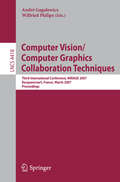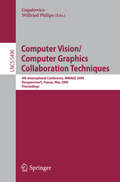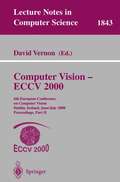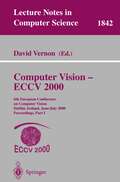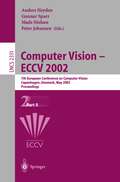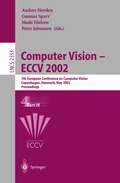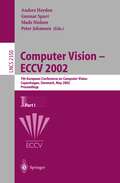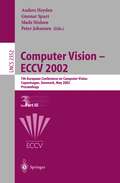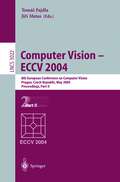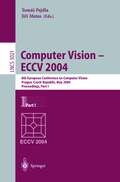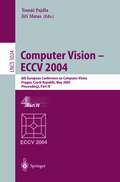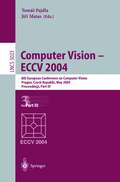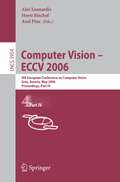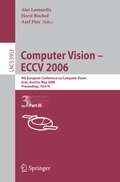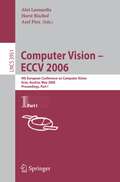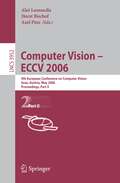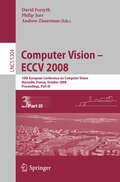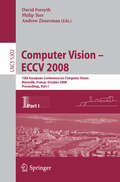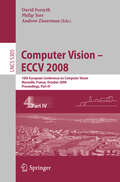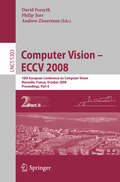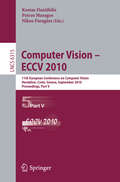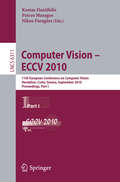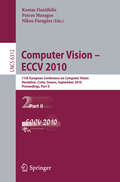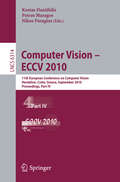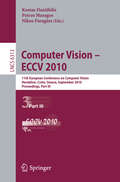- Table View
- List View
Computer Vision/Computer Graphics Collaboration Techniques: Third International Conference on Computer Vision/Computer Graphics, MIRAGE 2007, Rocquencourt, France, March 28-30, 2007, Proceedings (Lecture Notes in Computer Science #4418)
by André Gagalowicz Wilfried PhilipsThis book constitutes the refereed proceedings of the Third International Conference on Computer Vision/Computer Graphics collaboration techniques involving image analysis/synthesis approaches MIRAGE 2007, held in Rocquencourt, France, in March 2007. The 55 revised full cover foundational, methodological, and application issues.
Computer Vision/Computer Graphics Collaboration Techniques: 4th International Conference, MIRAGE 2009, Rocquencourt, France, May 4-6, 2009, Proceedings (Lecture Notes in Computer Science #5496)
by André Gagalowicz Wilfried PhilipsThis book constitutes the refereed proceedings of the 4th International Conference on Computer Vision/Computer Graphics Collaboration Techniques, MIRAGE 2009, held in Rocquencourt, France, in May 2009. The 41 revised full papers presented were carefully reviewed and selected from a total of 83 submissions. The papers cover a wide range of topics with focus on Computer Vision/Computer Graphics collaboration techniques involving image analysis/synthesis approaches especially concerning theoretical, computational, experimental or industrial aspects of model-based image analysis and image-based model synthesis.
Computer Vision - ECCV 2000: 6th European Conference on Computer Vision Dublin, Ireland, June 26 - July 1, 2000, Proceedings, Part II (Lecture Notes in Computer Science #1843)
by David VernonThe two-volume set LNCS 1842/1843 constitutes the refereed proceedings of the 6th European Conference on Computer Vision, ECCV 2000, held in Dublin, Ireland in June/July 2000. The 116 revised full papers presented were carefully selected from a total of 266 submissions. The two volumes offer topical sections on recognitions and modelling; stereoscopic vision; texture and shading; shape; structure from motion; image features; active, real-time, and robot vision; segmentation and grouping; vision systems engineering and evaluation; calibration; medical image understanding; and visual motion.
Computer Vision - ECCV 2000: 6th European Conference on Computer Vision Dublin, Ireland, June 26 - July 1, 2000 Proceedings, Part I (Lecture Notes in Computer Science #1842)
by David VernonTen years ago, the inaugural European Conference on Computer Vision was held in Antibes, France. Since then, ECCV has been held biennially under the auspices of the European Vision Society at venues around Europe. This year, the privilege of organizing ECCV 2000 falls to Ireland and it is a signal honour for us to host what has become one of the most important events in the calendar of the computer vision community. ECCV is a single-track conference comprising the highest quality, previously unpublished, contributed papers on new and original research in computer vision. This year, 266 papers were submitted and, following a rigorous double-blind review process, with each paper being reviewed by three referees, 116 papers were selected by the Programme Committee for presentation at the conference. The venue for ECCV 2000 is the University of Dublin, Trinity College. - unded in 1592, it is Ireland’s oldest university and has a proud tradition of scholarship in the Arts, Humanities, and Sciences, alike. The Trinity campus, set in the heart of Dublin, is an oasis of tranquility and its beautiful squares, elegant buildings, and tree-lined playing- elds provide the perfect setting for any conference.
Computer Vision - ECCV 2002: 7th European Conference on Computer Vision, Copenhagen, Denmark, May 28-31, 2002. Proceedings. Part II (Lecture Notes in Computer Science #2351)
by Anders Heyden Gunnar Sparr Mads Nielsen Peter JohansenPremiering in 1990 in Antibes, France, the European Conference on Computer Vision, ECCV, has been held biennially at venues all around Europe. These conferences have been very successful, making ECCV a major event to the computer vision community. ECCV 2002 was the seventh in the series. The privilege of organizing it was shared by three universities: The IT University of Copenhagen, the University of Copenhagen, and Lund University, with the conference venue in Copenhagen. These universities lie ¨ geographically close in the vivid Oresund region, which lies partly in Denmark and partly in Sweden, with the newly built bridge (opened summer 2000) crossing the sound that formerly divided the countries. We are very happy to report that this year’s conference attracted more papers than ever before, with around 600 submissions. Still, together with the conference board, we decided to keep the tradition of holding ECCV as a single track conference. Each paper was anonymously refereed by three different reviewers. For the nal selection, for the rst time for ECCV, a system with area chairs was used. These met with the program chairsinLundfortwodaysinFebruary2002toselectwhatbecame45oralpresentations and 181 posters.Also at this meeting the selection was made without knowledge of the authors’identity.
Computer Vision - ECCV 2002: 7th European Conference on Computer Vision, Copenhagen, Denmark, May 28-31, 2002. Proceedings. Part IV (Lecture Notes in Computer Science #2353)
by Anders Heyden Gunnar Sparr Mads Nielsen Peter JohansenPremiering in 1990 in Antibes, France, the European Conference on Computer Vision, ECCV, has been held biennially at venues all around Europe. These conferences have been very successful, making ECCV a major event to the computer vision community. ECCV 2002 was the seventh in the series. The privilege of organizing it was shared by three universities: The IT University of Copenhagen, the University of Copenhagen, and Lund University, with the conference venue in Copenhagen. These universities lie ¨ geographically close in the vivid Oresund region, which lies partly in Denmark and partly in Sweden, with the newly built bridge (opened summer 2000) crossing the sound that formerly divided the countries. We are very happy to report that this year’s conference attracted more papers than ever before, with around 600 submissions. Still, together with the conference board, we decided to keep the tradition of holding ECCV as a single track conference. Each paper was anonymously refereed by three different reviewers. For the nal selection, for the rst time for ECCV, a system with area chairs was used. These met with the program chairsinLundfortwodaysinFebruary2002toselectwhatbecame45oralpresentations and 181 posters.Also at this meeting the selection was made without knowledge of the authors’identity.
Computer Vision - ECCV 2002: 7th European Conference on Computer Vision, Copenhagen, Denmark, May 28-31, 2002, Proceedings, Part I (Lecture Notes in Computer Science #2350)
by Anders Heyden Gunnar Sparr Mads Nielsen Peter JohansenPremiering in 1990 in Antibes, France, the European Conference on Computer Vision, ECCV, has been held biennially at venues all around Europe. These conferences have been very successful, making ECCV a major event to the computer vision community. ECCV 2002 was the seventh in the series. The privilege of organizing it was shared by three universities: The IT University of Copenhagen, the University of Copenhagen, and Lund University, with the conference venue in Copenhagen. These universities lie ¨ geographically close in the vivid Oresund region, which lies partly in Denmark and partly in Sweden, with the newly built bridge (opened summer 2000) crossing the sound that formerly divided the countries. We are very happy to report that this year’s conference attracted more papers than ever before, with around 600 submissions. Still, together with the conference board, we decided to keep the tradition of holding ECCV as a single track conference. Each paper was anonymously refereed by three different reviewers. For the ?nal selection, for the ?rst time for ECCV, a system with area chairs was used. These met with the program chairsinLundfortwodaysinFebruary2002toselectwhatbecame45oralpresentations and 181 posters.Also at this meeting the selection was made without knowledge of the authors’identity.
Computer Vision - ECCV 2002: 7th European Conference on Computer Vision, Copenhagen, Denmark, May 28-31, 2002, Proceedings, Part III (Lecture Notes in Computer Science #2352)
by Anders Heyden Gunnar Sparr Mads Nielsen Peters JohansenPremiering in 1990 in Antibes, France, the European Conference on Computer Vision, ECCV, has been held biennially at venues all around Europe. These conferences have been very successful, making ECCV a major event to the computer vision community. ECCV 2002 was the seventh in the series. The privilege of organizing it was shared by three universities: The IT University of Copenhagen, the University of Copenhagen, and Lund University, with the conference venue in Copenhagen. These universities lie ¨ geographically close in the vivid Oresund region, which lies partly in Denmark and partly in Sweden, with the newly built bridge (opened summer 2000) crossing the sound that formerly divided the countries. We are very happy to report that this year’s conference attracted more papers than ever before, with around 600 submissions. Still, together with the conference board, we decided to keep the tradition of holding ECCV as a single track conference. Each paper was anonymously refereed by three different reviewers. For the nal selection, for the rst time for ECCV, a system with area chairs was used. These met with the program chairsinLundfortwodaysinFebruary2002toselectwhatbecame45oralpresentations and 181 posters.Also at this meeting the selection was made without knowledge of the authors’identity.
Computer Vision - ECCV 2004: 8th European Conference on Computer Vision, Prague, Czech Republic, May 11-14, 2004. Proceedings, Part II (Lecture Notes in Computer Science #3022)
by Tomas Pajdla Jiri MatasWelcome to the proceedings of the 8th European Conference on Computer - sion! Following a very successful ECCV 2002, the response to our call for papers was almost equally strong – 555 papers were submitted. We accepted 41 papers for oral and 149 papers for poster presentation. Several innovations were introduced into the review process. First, the n- ber of program committee members was increased to reduce their review load. We managed to assign to program committee members no more than 12 papers. Second, we adopted a paper ranking system. Program committee members were asked to rank all the papers assigned to them, even those that were reviewed by additional reviewers. Third, we allowed authors to respond to the reviews consolidated in a discussion involving the area chair and the reviewers. Fourth, thereports,thereviews,andtheresponsesweremadeavailabletotheauthorsas well as to the program committee members. Our aim was to provide the authors with maximal feedback and to let the program committee members know how authors reacted to their reviews and how their reviews were or were not re?ected in the ?nal decision. Finally, we reduced the length of reviewed papers from 15 to 12 pages. ThepreparationofECCV2004wentsmoothlythankstothee?ortsofthe- ganizing committee, the area chairs, the program committee, and the reviewers. We are indebted to Anders Heyden, Mads Nielsen, and Henrik J. Nielsen for passing on ECCV traditions and to Dominique Asselineau from ENST/TSI who kindly provided his GestRFIA conference software. We thank Jan-Olof Eklundh and Andrew Zisserman for encouraging us to organize ECCV 2004 in Prague.
Computer Vision - ECCV 2004: 8th European Conference on Computer Vision, Prague, Czech Republic, May 11-14, 2004. Proceedings, Part I (Lecture Notes in Computer Science #3021)
by Tomas Pajdla Jiri MatasWelcome to the proceedings of the 8th European Conference on Computer - sion! Following a very successful ECCV 2002, the response to our call for papers was almost equally strong – 555 papers were submitted. We accepted 41 papers for oral and 149 papers for poster presentation. Several innovations were introduced into the review process. First, the n- ber of program committee members was increased to reduce their review load. We managed to assign to program committee members no more than 12 papers. Second, we adopted a paper ranking system. Program committee members were asked to rank all the papers assigned to them, even those that were reviewed by additional reviewers. Third, we allowed authors to respond to the reviews consolidated in a discussion involving the area chair and the reviewers. Fourth, thereports,thereviews,andtheresponsesweremadeavailabletotheauthorsas well as to the program committee members. Our aim was to provide the authors with maximal feedback and to let the program committee members know how authors reacted to their reviews and how their reviews were or were not re?ected in the ?nal decision. Finally, we reduced the length of reviewed papers from 15 to 12 pages. ThepreparationofECCV2004wentsmoothlythankstothee?ortsofthe- ganizing committee, the area chairs, the program committee, and the reviewers. We are indebted to Anders Heyden, Mads Nielsen, and Henrik J. Nielsen for passing on ECCV traditions and to Dominique Asselineau from ENST/TSI who kindly provided his GestRFIA conference software. We thank Jan-Olof Eklundh and Andrew Zisserman for encouraging us to organize ECCV 2004 in Prague.
Computer Vision - ECCV 2004: 8th European Conference on Computer Vision, Prague, Czech Republic, May 11-14, 2004. Proceedings, Part IV (Lecture Notes in Computer Science #3024)
by Tomas Pajdla Jiri MatasWelcome to the proceedings of the 8th European Conference on Computer - sion! Following a very successful ECCV 2002, the response to our call for papers was almost equally strong – 555 papers were submitted. We accepted 41 papers for oral and 149 papers for poster presentation. Several innovations were introduced into the review process. First, the n- ber of program committee members was increased to reduce their review load. We managed to assign to program committee members no more than 12 papers. Second, we adopted a paper ranking system. Program committee members were asked to rank all the papers assigned to them, even those that were reviewed by additional reviewers. Third, we allowed authors to respond to the reviews consolidated in a discussion involving the area chair and the reviewers. Fourth, thereports,thereviews,andtheresponsesweremadeavailabletotheauthorsas well as to the program committee members. Our aim was to provide the authors with maximal feedback and to let the program committee members know how authors reacted to their reviews and how their reviews were or were not re?ected in the ?nal decision. Finally, we reduced the length of reviewed papers from 15 to 12 pages. ThepreparationofECCV2004wentsmoothlythankstothee?ortsofthe- ganizing committee, the area chairs, the program committee, and the reviewers. We are indebted to Anders Heyden, Mads Nielsen, and Henrik J. Nielsen for passing on ECCV traditions and to Dominique Asselineau from ENST/TSI who kindly provided his GestRFIA conference software. We thank Jan-Olof Eklundh and Andrew Zisserman for encouraging us to organize ECCV 2004 in Prague.
Computer Vision - ECCV 2004: 8th European Conference on Computer Vision, Prague, Czech Republic, May 11-14, 2004. Proceedings, Part III (Lecture Notes in Computer Science #3023)
by Tomas Pajdla Jiri MatasWelcome to the proceedings of the 8th European Conference on Computer - sion! Following a very successful ECCV 2002, the response to our call for papers was almost equally strong – 555 papers were submitted. We accepted 41 papers for oral and 149 papers for poster presentation. Several innovations were introduced into the review process. First, the n- ber of program committee members was increased to reduce their review load. We managed to assign to program committee members no more than 12 papers. Second, we adopted a paper ranking system. Program committee members were asked to rank all the papers assigned to them, even those that were reviewed by additional reviewers. Third, we allowed authors to respond to the reviews consolidated in a discussion involving the area chair and the reviewers. Fourth, thereports,thereviews,andtheresponsesweremadeavailabletotheauthorsas well as to the program committee members. Our aim was to provide the authors with maximal feedback and to let the program committee members know how authors reacted to their reviews and how their reviews were or were not re?ected in the ?nal decision. Finally, we reduced the length of reviewed papers from 15 to 12 pages. ThepreparationofECCV2004wentsmoothlythankstothee?ortsofthe- ganizing committee, the area chairs, the program committee, and the reviewers. We are indebted to Anders Heyden, Mads Nielsen, and Henrik J. Nielsen for passing on ECCV traditions and to Dominique Asselineau from ENST/TSI who kindly provided his GestRFIA conference software. We thank Jan-Olof Eklundh and Andrew Zisserman for encouraging us to organize ECCV 2004 in Prague.
Computer Vision -- ECCV 2006: 9th European Conference on Computer Vision, Graz, Austria, May 7-13, 2006, Proceedings, Part IV (Lecture Notes in Computer Science #3954)
by Ales Leonardis Horst Bischof Axel PinzComputer Vision -- ECCV 2006: 9th European Conference on Computer Vision, Graz, Austria, May 7-13, 2006, Proceedings, Part III (Lecture Notes in Computer Science #3953)
by Ales Leonardis Horst Bischof Axel PinzComputer Vision -- ECCV 2006: 9th European Conference on Computer Vision, Graz, Austria, May 7-13, 2006, Proceedings, Part I (Lecture Notes in Computer Science #3951)
by Ales Leonardis Horst Bischof Axel PinzThe four-volume set comprising LNCS volumes 3951/3952/3953/3954 constitutes the refereed proceedings of the 9th European Conference on Computer Vision, ECCV 2006. The 192 papers presented cover the entire range of current issues in computer vision. The papers are organized in topical sections on recognition, statistical models and visual learning, 3D reconstruction and multi-view geometry, energy minimization, tracking and motion, segmentation, shape from X, visual tracking, face detection and recognition, and more.
Computer Vision -- ECCV 2006: 9th European Conference on Computer Vision, Graz, Austria, May 7-13, 2006, Proceedings, Part II (Lecture Notes in Computer Science #3952)
by Ales Leonardis Horst Bischof Axel PinzComputer Vision - ECCV 2008: 10th European Conference on Computer Vision, Marseille, France, October 12-18, 2008, Proceedings, Part III (Lecture Notes in Computer Science #5304)
by David Forsyth Philip Torr Andrew ZissermanWelcome to the 2008EuropeanConference onComputer Vision. These proce- ings are the result of a great deal of hard work by many people. To produce them, a total of 871 papers were reviewed. Forty were selected for oral pres- tation and 203 were selected for poster presentation, yielding acceptance rates of 4.6% for oral, 23.3% for poster, and 27.9% in total. Weappliedthreeprinciples.First,sincewehadastronggroupofAreaChairs, the ?nal decisions to accept or reject a paper rested with the Area Chair, who wouldbeinformedbyreviewsandcouldactonlyinconsensuswithanotherArea Chair. Second, we felt that authors were entitled to a summary that explained how the Area Chair reached a decision for a paper. Third, we were very careful to avoid con?icts of interest. Each paper was assigned to an Area Chair by the Program Chairs, and each Area Chair received a pool of about 25 papers. The Area Chairs then identi?ed and rankedappropriatereviewersfor eachpaper in their pool, and a constrained optimization allocated three reviewers to each paper. We are very proud that every paper received at least three reviews. At this point, authors were able to respond to reviews. The Area Chairs then needed to reach a decision. We used a series of procedures to ensure careful review and to avoid con?icts of interest. ProgramChairs did not submit papers. The Area Chairs were divided into three groups so that no Area Chair in the group was in con?ict with any paper assigned to any Area Chair in the group.
Computer Vision - ECCV 2008: 10th European Conference on Computer Vision, Marseille, France, October 12-18, 2008, Proceedings, Part I (Lecture Notes in Computer Science #5302)
by David Forsyth Philip Torr Andrew ZissermanWelcome to the 2008EuropeanConference onComputer Vision. These proce- ings are the result of a great deal of hard work by many people. To produce them, a total of 871 papers were reviewed. Forty were selected for oral pres- tation and 203 were selected for poster presentation, yielding acceptance rates of 4.6% for oral, 23.3% for poster, and 27.9% in total. Weappliedthreeprinciples.First,sincewehadastronggroupofAreaChairs, the ?nal decisions to accept or reject a paper rested with the Area Chair, who wouldbeinformedbyreviewsandcouldactonlyinconsensuswithanotherArea Chair. Second, we felt that authors were entitled to a summary that explained how the Area Chair reached a decision for a paper. Third, we were very careful to avoid con?icts of interest. Each paper was assigned to an Area Chair by the Program Chairs, and each Area Chair received a pool of about 25 papers. The Area Chairs then identi?ed and rankedappropriatereviewersfor eachpaper in their pool, and a constrained optimization allocated three reviewers to each paper. We are very proud that every paper received at least three reviews. At this point, authors were able to respond to reviews. The Area Chairs then needed to reach a decision. We used a series of procedures to ensure careful review and to avoid con?icts of interest. ProgramChairs did not submit papers. The Area Chairs were divided into three groups so that no Area Chair in the group was in con?ict with any paper assigned to any Area Chair in the group.
Computer Vision - ECCV 2008: 10th European Conference on Computer Vision, Marseille, France, October 12-18, 2008, Proceedings, Part IV (Lecture Notes in Computer Science #5305)
by David Forsyth Philip Torr Andrew ZissermanWelcome to the 2008EuropeanConference onComputer Vision. These proce- ings are the result of a great deal of hard work by many people. To produce them, a total of 871 papers were reviewed. Forty were selected for oral pres- tation and 203 were selected for poster presentation, yielding acceptance rates of 4.6% for oral, 23.3% for poster, and 27.9% in total. Weappliedthreeprinciples.First,sincewehadastronggroupofAreaChairs, the ?nal decisions to accept or reject a paper rested with the Area Chair, who wouldbeinformedbyreviewsandcouldactonlyinconsensuswithanotherArea Chair. Second, we felt that authors were entitled to a summary that explained how the Area Chair reached a decision for a paper. Third, we were very careful to avoid con?icts of interest. Each paper was assigned to an Area Chair by the Program Chairs, and each Area Chair received a pool of about 25 papers. The Area Chairs then identi?ed and rankedappropriatereviewersfor eachpaper in their pool, and a constrained optimization allocated three reviewers to each paper. We are very proud that every paper received at least three reviews. At this point, authors were able to respond to reviews. The Area Chairs then needed to reach a decision. We used a series of procedures to ensure careful review and to avoid con?icts of interest. ProgramChairs did not submit papers. The Area Chairs were divided into three groups so that no Area Chair in the group was in con?ict with any paper assigned to any Area Chair in the group.
Computer Vision - ECCV 2008: 10th European Conference on Computer Vision, Marseille, France, October 12-18, 2008. Proceedings, Part II (Lecture Notes in Computer Science #5303)
by David Forsyth Philip Torr Andrew ZissermanThe four-volume set comprising LNCS volumes 5302/5303/5304/5305 constitutes the refereed proceedings of the 10th European Conference on Computer Vision, ECCV 2008, held in Marseille, France, in October 2008. The 243 revised papers presented were carefully reviewed and selected from a total of 871 papers submitted. The four books cover the entire range of current issues in computer vision. The papers are organized in topical sections on recognition, stereo, people and face recognition, object tracking, matching, learning and features, MRFs, segmentation, computational photography and active reconstruction.
Computer Vision -- ECCV 2010: 11th European Conference on Computer Vision, Heraklion, Crete, Greece, September 5-11, 2010, Proceedings, Part V (Lecture Notes in Computer Science #6315)
by Kostas Daniilidis Petros Maragos Nikos ParagiosThe 2010 edition of the European Conference on Computer Vision was held in Heraklion, Crete. The call for papers attracted an absolute record of 1,174 submissions. We describe here the selection of the accepted papers: Thirty-eight area chairs were selected coming from Europe (18), USA and Canada (16), and Asia (4). Their selection was based on the following criteria: (1) Researchers who had served at least two times as Area Chairs within the past two years at major vision conferences were excluded; (2) Researchers who served as Area Chairs at the 2010 Computer Vision and Pattern Recognition were also excluded (exception: ECCV 2012 Program Chairs); (3) Minimization of overlap introduced by Area Chairs being former student and advisors; (4) 20% of the Area Chairs had never served before in a major conference; (5) The Area Chair selection process made all possible efforts to achieve a reasonable geographic distribution between countries, thematic areas and trends in computer vision. Each Area Chair was assigned by the Program Chairs between 28–32 papers. Based on paper content, the Area Chair recommended up to seven potential reviewers per paper. Such assignment was made using all reviewers in the database including the conflicting ones. The Program Chairs manually entered the missing conflict domains of approximately 300 reviewers. Based on the recommendation of the Area Chairs, three reviewers were selected per paper (with at least one being of the top three suggestions), with 99.
Computer Vision -- ECCV 2010: 11th European Conference on Computer Vision, Heraklion, Crete, Greece, September 5-11, 2010, Proceedings, Part I (Lecture Notes in Computer Science #6311)
by Kostas Daniilidis Petros Maragos Nikos ParagiosThe 2010 edition of the European Conference on Computer Vision was held in Heraklion, Crete. The call for papers attracted an absolute record of 1,174 submissions. We describe here the selection of the accepted papers: ? Thirty-eight area chairs were selected coming from Europe (18), USA and Canada (16), and Asia (4). Their selection was based on the following criteria: (1) Researchers who had served at least two times as Area Chairs within the past two years at major vision conferences were excluded; (2) Researchers who served as Area Chairs at the 2010 Computer Vision and Pattern Recognition were also excluded (exception: ECCV 2012 Program Chairs); (3) Minimization of overlap introduced by Area Chairs being former student and advisors; (4) 20% of the Area Chairs had never served before in a major conference; (5) The Area Chair selection process made all possible efforts to achieve a reasonable geographic distribution between countries, thematic areas and trends in computer vision. ? Each Area Chair was assigned by the Program Chairs between 28–32 papers. Based on paper content, the Area Chair recommended up to seven potential reviewers per paper. Such assignment was made using all reviewers in the database including the conflicting ones. The Program Chairs manually entered the missing conflict domains of approximately 300 reviewers. Based on the recommendation of the Area Chairs, three reviewers were selected per paper (with at least one being of the top three suggestions), with 99.
Computer Vision -- ECCV 2010: 11th European Conference on Computer Vision, Heraklion, Crete, Greece, September 5-11, 2010, Proceedings, Part II (Lecture Notes in Computer Science #6312)
by Kostas Daniilidis Petros Maragos Nikos ParagiosThe 2010 edition of the European Conference on Computer Vision was held in Heraklion, Crete. The call for papers attracted an absolute record of 1,174 submissions. We describe here the selection of the accepted papers: Thirty-eight area chairs were selected coming from Europe (18), USA and Canada (16), and Asia (4). Their selection was based on the following criteria: (1) Researchers who had served at least two times as Area Chairs within the past two years at major vision conferences were excluded; (2) Researchers who served as Area Chairs at the 2010 Computer Vision and Pattern Recognition were also excluded (exception: ECCV 2012 Program Chairs); (3) Minimization of overlap introduced by Area Chairs being former student and advisors; (4) 20% of the Area Chairs had never served before in a major conference; (5) The Area Chair selection process made all possible efforts to achieve a reasonable geographic distribution between countries, thematic areas and trends in computer vision. Each Area Chair was assigned by the Program Chairs between 28–32 papers. Based on paper content, the Area Chair recommended up to seven potential reviewers per paper. Such assignment was made using all reviewers in the database including the conflicting ones. The Program Chairs manually entered the missing conflict domains of approximately 300 reviewers. Based on the recommendation of the Area Chairs, three reviewers were selected per paper (with at least one being of the top three suggestions), with 99.
Computer Vision -- ECCV 2010: 11th European Conference on Computer Vision, Heraklion, Crete, Greece, September 5-11, 2010, Proceedings, Part IV (Lecture Notes in Computer Science #6314)
by Kostas Daniilidis Petros Maragos Nikos ParagiosThe 2010 edition of the European Conference on Computer Vision was held in Heraklion, Crete. The call for papers attracted an absolute record of 1,174 submissions. We describe here the selection of the accepted papers: Thirty-eight area chairs were selected coming from Europe (18), USA and Canada (16), and Asia (4). Their selection was based on the following criteria: (1) Researchers who had served at least two times as Area Chairs within the past two years at major vision conferences were excluded; (2) Researchers who served as Area Chairs at the 2010 Computer Vision and Pattern Recognition were also excluded (exception: ECCV 2012 Program Chairs); (3) Minimization of overlap introduced by Area Chairs being former student and advisors; (4) 20% of the Area Chairs had never served before in a major conference; (5) The Area Chair selection process made all possible efforts to achieve a reasonable geographic distribution between countries, thematic areas and trends in computer vision. Each Area Chair was assigned by the Program Chairs between 28–32 papers. Based on paper content, the Area Chair recommended up to seven potential reviewers per paper. Such assignment was made using all reviewers in the database including the conflicting ones. The Program Chairs manually entered the missing conflict domains of approximately 300 reviewers. Based on the recommendation of the Area Chairs, three reviewers were selected per paper (with at least one being of the top three suggestions), with 99.
Computer Vision -- ECCV 2010: 11th European Conference on Computer Vision, Heraklion, Crete, Greece, September 5-11, 2010, Proceedings, Part III (Lecture Notes in Computer Science #6313)
by Kostas Daniilidis Petros Maragos Nikos ParagiosThe 2010 edition of the European Conference on Computer Vision was held in Heraklion, Crete. The call for papers attracted an absolute record of 1,174 submissions. We describe here the selection of the accepted papers: Thirty-eight area chairs were selected coming from Europe (18), USA and Canada (16), and Asia (4). Their selection was based on the following criteria: (1) Researchers who had served at least two times as Area Chairs within the past two years at major vision conferences were excluded; (2) Researchers who served as Area Chairs at the 2010 Computer Vision and Pattern Recognition were also excluded (exception: ECCV 2012 Program Chairs); (3) Minimization of overlap introduced by Area Chairs being former student and advisors; (4) 20% of the Area Chairs had never served before in a major conference; (5) The Area Chair selection process made all possible efforts to achieve a reasonable geographic distribution between countries, thematic areas and trends in computer vision. Each Area Chair was assigned by the Program Chairs between 28–32 papers. Based on paper content, the Area Chair recommended up to seven potential reviewers per paper. Such assignment was made using all reviewers in the database including the conflicting ones. The Program Chairs manually entered the missing conflict domains of approximately 300 reviewers. Based on the recommendation of the Area Chairs, three reviewers were selected per paper (with at least one being of the top three suggestions), with 99.
